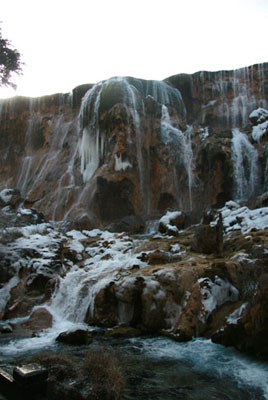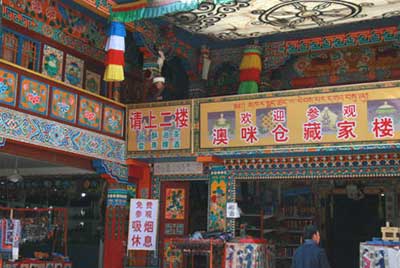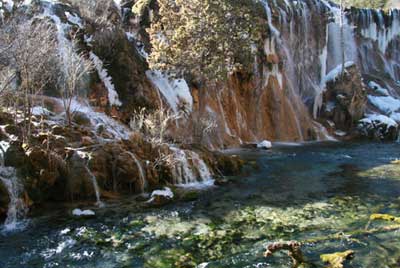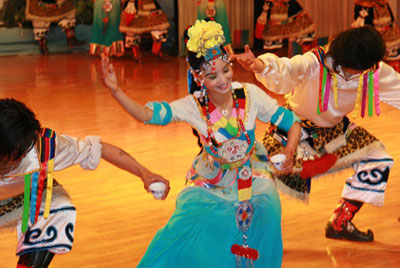Jiuzhaigou becomes a fairyland full of glittering ice waterfalls and snow-capped mountains each winter. This year, the icy season is expected to last through March 31. Located in the Aba Tibetan-Qiang Autonomous Prefecture in southwestern China's Sichuan Province, Jiuzhaigou was listed as a UNESCO World Heritage Site in 1992. [Photo: CRIENGLISH.com]
With its snow-capped mountains, glittering and translucent ice waterfall and sapphire lakes scattered among the valleys, Jiuzhaigou is an enchanting winter destination.
The striking blend of the blue water and grayish trees composes a more profound visual effect of cold beauty, providing a pleasant contrast to Jiuzhaigou in autumn, its peak season.
Many visitors who attended the fourth Ice Waterfall Tourism Festival earlier in January were surprised at how well-preserved the area's natural resources are, considering that 20,000 visitors flock to Jiuzhaigou daily during the peak season.
Jiuzhaigou, widely considered one of the most beautiful places in China, was listed as a World Heritage Site in 1992. It is also credited as a geographic park and a 5A-level national scenic spot.
As the only domestic scenic spot with these three designations, it has become a hot destination for tourists. Despite its remote location in Aba Tibetan-Qiang Autonomous Prefecture, every year vast numbers of visitors come to drink in the beautiful landscape and experience the exotic Tibetan culture. As a result, over the past decade, many changes have taken place in this once-quiet valley.
Tourism has now become Aba's major industry; statistics show the area received 8.8 million visitors and tourism revenues of more than 7.4 billion yuan last year. Yet, most visitors travel many hours just stay for a day or two. Why does it seem that people are not content to remain in Jiuzhaigou? With its abundant cultural offerings from nine ethnic villages, the area certainly doesn't lack the human element that is often part of a destination's appeal. So what's missing from this remote wonderland?
Luosangdongzhu, a local Tibetan resident, has converted his family's home into the Aomicang Tibetan House, a family-style store. The business sells suyoucha, a buttered tea, or qingkejiu, a barley alcohol, as well as some daily necessities to visiting tourists. [Photo: CRIENGLISH.com]
Tourism Impacts on Local Life
The valley is home to more than 1,000 Tibetans from nine villages. When the local government began developing the tourism industry, arable lands were reclaimed for reforestation or tourism-related construction, and local farmers and herdsman found new livelihoods to survive in a region now dominated by tourism.
At the folk culture park in Shuzheng Valley, the largest of the nine local communities, almost every household has been converted into a shop dealing in Tibetan stone accessories, silver ornaments, leather hats or other local handicrafts. Though the products barely differ from shop to shop, curious visitors often hop from door-to-door to experience as much local flavor as possible.
Luosangdongzhu runs the Aomicang Tibetan House located at the entrance of the park. He adapted his home into a family-style shop, where visitors can taste suyoucha, a buttered tea, or qingkejiu, a local barley alcohol. The shop also sells daily necessities. After years in business, the family has made big money in step with the rising number of visitors. Luosangdongzhu said he spent about 300,000 yuan building the house a couple of years ago. With its combination of red, blue and yellow figures covering the walls, the house now represents what outsiders imagine to be a typical Tibetan family.
The tide of tourism has brought prosperity to the locals, who were formerly isolated in the deep valley, and the concept of an outside world has become more of a reality as they meet and greet visitors from around the country and abroad.
Kangzhuzeren, 20, wants to be a taxi driver inside the scenic area. His family began running a photography business in 2000. In addition to taking basic photos from their stand inside the park, they rent ethnic costumes and when it was permitted, a yak, for added flair. They charged one or two yuan to rent a costume when they first opened, but the price has now risen to ten yuan. In the peak season, the family can earn 10,000 yuan per month, a figure at least on par with the incomes of some urban white-collar workers. The owner of a small local supermarket said he has to import goods daily from Chengdu, the provincial capital, during the peak season.
The tourism boom has so far stimulated the economy without destroying the area's natural beauty. But keeping up with travel trends often comes at a cost. People don't necessarily want to come and see just the mountains anymore. Now, they want a combination vacation package full of cultural and interactive elements, rather than a simple, return-to-nature getaway.
Jiuzhaigou becomes a fairyland full of glittering ice waterfalls and snow-capped mountains each winter. This year, the icy season is expected to last through March 31. Located in the Aba Tibetan-Qiang Autonomous Prefecture in southwestern China's Sichuan Province, Jiuzhaigou was listed as a UNESCO World Heritage Site in 1992. [Photo: CRIENGLISH.com]
Establishing a Favorable Tourism Environment
But how should the local government deal with the potential conflicts between the local communities and tourism industries? What can be done to maintain a balance?
"Potential conflict between local communities and the development is likely, if the integration is not well-managed. And if there are no educational programs or awareness programs, things can go wrong," Xu Jing, director of the Asia Pacific Region of the United Nations World Tourism Organization, said.
"Tourism is like the relationship between water and a boat. On one hand, the water can support the boat, but on the other, it can also upend the boat -- it depends how you do it," he said. He praised Jiuzhaigou as a good example of a balanced approach between the two.
A favorable environment for tourism must offer multiple attractions. In future, Xu thinks Jiuzhaigou should focus on complementing the natural beauty with cultural products.
"So far it is mainly concentrating on the natural resources, but to retain those natural resources as the core element, like the petals on a flower, you need the side product to support it. I think a cultural element, like the one here (at the Sheraton resort), the Tibetan culture or other historical resources would function as the green leaves to those flower petals, essential to their survival."
According to Mark Frood, the North Asia regional manager for the New Zealand Tourism Administration, when people visit, they must have an exceptional experience that they want to share with their friends. If visitors talk about the region back at home, it is the best promotion an area can get.
No other element endears a place to a visitor more than favorable interactions with the local residents. But often visitors encounter open hostility to their presence, a problem the local government can't afford to neglect.
Xu said the reason why some local communities have become hostile toward tourism is poor pre-development planning. If governments involved the local communities in the decision-making process before development began, the degree of their hostility would likely be much lower. When a government decides to develop an area to better attract tourists, it must consult the community to make the arrangement mutually beneficial.
In Guizhou, when people want to visit ethnic groups, the village chief can form a tourism association so each tour group can visit two or three houses, Xu said. The locals who are paid visits receive economic returns, and in this way, they become part of the process, rather passive receivers missing out on the benefits.
Local Tibetan people in traditional dress take the stage at the grand theater of the Sheraton Jiuzhaigou Resort for a performance of Tibetan customs and religious rituals on January 9, 2008. A dozen such performing troupes reportedly work in Jiuzhaigou during the prime season. [Photo: CRIENGLISH.com]
How to Preserve and Promote Tibetan Culture in the Region
Alai, a famous Tibetan writer from Aba and the winner of the Fifth National Mao Dun Literature Prize, the highest literary award in China, also attended the Ice Waterfall Tourism Festival.
Alai praised management in Jiuzhaigou for their effective conservation work. But when it comes to the human aspect, the writer expressed deep concern. Alai said the issue concerns not only Jiuzhaigou, but all of the scenic spots in China.
"There is a general trend that, when we talk about culture, we do not think of it as related to people's lifestyle or livelihoods. We think of it as ritualistic, like the wedding ceremonies and funerals, or the styles of singing, dancing and dressing -- these sort of superficial things. In Jiuzhaigou, they have done very well by abstracting these things and presenting them to visitors in a commercialized way."
There are a dozen performance art troupes in Jiuzhaigou, which stage traditional Tibetan and Qiang rituals in a variety of performances. This type of performance, called "pure culture" by the locals, brought in 130 million yuan last year, a striking figure compared to those of other scenic spots in China.
"The connotation of culture should be widened, considering that we still have living villages in the scenic valleys. We see at present that the locals have been changed a lot by tourism. They have already shifted from farming to offering tourism services, and have gained considerable economic returns from it. What about preserving more of the original flavor of the Tibetan culture, including its architecture and functions? Much has changed, such as the flashy, over-decorated houses. These aren't necessary at all. Just present them the way they were."
Alai stressed the importance of exploring the diverse biological resources. Just a dozen miles away, he said, lies a golden monkey habitat. The locals have cultivated close relationships with nature, and it's said that some villagers even have the ability to summon the monkey. We need to think twice about what "culture" really means, he said.
But developing tourism always has its pros and cons. Local officials have realized the problems, and they are not content with what they have already done. More efforts are being made to improve the area. But solving the issues is no small task, so that's why they held the forum to solicit suggestions from experts.
Alai thinks a better tourism model will be key to the area's future success.
Maybe it is not necessary to sell things for direct economic returns, he said. It would be profitable in the long term to simply have people come in and sit, drink some tea, and listen to stories of the local history.
Tibetan performers entertain the audience on January 9, 2008 during the Fourth Ice Waterfall Tourism Festival in Jiuzhaigou, Aba Tibetan-Qiang Autonomous Prefecture, in northeastern Sichuan Province. [Photo: CRIENGLISH.com]
(CRI January 16, 2008)






